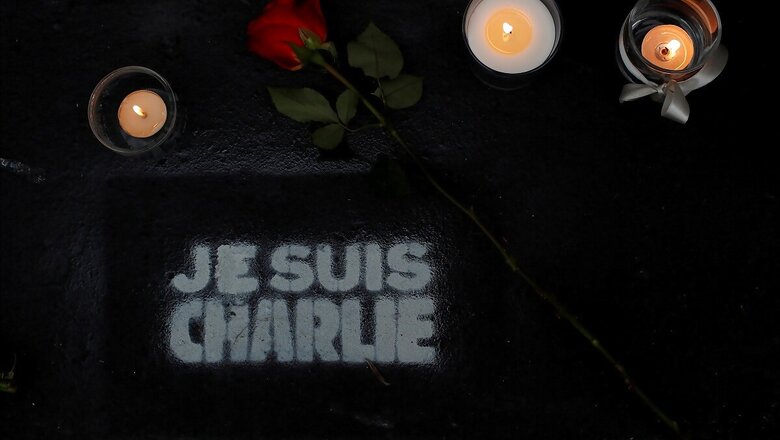
views
The clock has yet to strike midday on Wednesday January 7, 2015 at the headquarters of French satirical magazine Charlie Hebdo on the second floor of a 1980s Parisian building.
On the table lies its latest issue, next to a cake. The first editorial meeting of the new year is drawing to a close.
A few minutes later, 12 people will be dead.
A couple of metres (yards) away outside, two armed men, dressed in black, point a Kalashnikov at cartoonist Corinne Rey, just back from picking up her daughter at day care.
Brothers Said and Cherif Kouachi have already shot dead the building maintenance worker Frederic Boisseau.
The attackers force Rey to tap in the code for the keypad entry to let them in the building, guarded since the publication of caricatures mocking the Prophet Mohammed and subsequent threats.
The gunmen follow Rey to the second floor, where they shoot webmaster Simon Fieschi, gravely injuring him.
“We heard shots, we didn’t know what it was,” Charlie Hebdo journalist Laurent Leger said the next day.
“Then the door opened, and a man sprang out shouting ‘Allahu Akbar'”.
“He looked like he was from the special forces, he was wearing a balaclava, all in black… and then the shooting began.”
– ‘They’re all dead’ –
Within a few minutes, editor-in-chief Stephane “Charb” Charbonnier and cartoonists Jean Cabut, Bernard Verlhac, Georges Wolinski and Philippe Honore are all dead, as well as economist Bernard Maris, columnist Elsa Cayat, Charb’s bodyguard Franck Brinsolaro, visitor Michel Renaud and proof-reader Mustapha Ourrad.
“We have avenged the Prophet Mohammed! We’ve killed Charlie Hebdo!” the attackers declaim as they flee.
But their planned exit route is blocked by a police car.
They open fire and kill their twelfth victim, police officer Ahmed Merabet, before heading to northeastern Paris.
Patrick Pelloux, emergency doctor and Charlie Hebdo columnist, is one of the first to arrive on the scene of the carnage.
Pelloux gets through to then-French president Francois Hollande on the phone.
“Weeping, he described the reality in front of him saying ‘they’re all dead'”, Hollande told AFP, five years after the tragedy.
Shortly afterwards, the survivors and the victims’ families huddle together in a theatre close to the newspaper’s headquarters.
“People brought us sweets, but we weren’t hungry, we were in complete shock,” said Pelloux.
As news of the deadly attack begins to spread, the hashtag #JeSuisCharlie (I am Charlie) floods social media.
In the evening, thousands gather spontaneously in Paris to denounce the attack and defend freedom of expression at Place de la Republique, lighting candles, raising pens skyward and carrying letters proclaiming, “Not Afraid”.
– ‘Coordinated operation’ –
Early the next morning, France is still grieving when a young police officer, Clarissa Jean-Philippe, is killed in the southern Paris suburb Montrouge.
The gunman, Amedy Coulibaly, shoots her in the back before fleeing.
Authorities initially dismiss any suggestion of a link between the shooting and the Charlie Hebdo attacks, but later confirm that they are connected.
“At the time, I am cautious but very quickly I had the feeling that we are facing a coordinated operation,” then-interior minister Bernard Cazeneuve told AFP.
Ninety minutes later and a dozen kilometres away, the Kouachi brothers steal food and petrol from a service station in the Aisne region, north east of Paris.
The manager recognises them and alerts the police.
The manhunt picks up pace as special forces comb a vast rural zone.
Police spot them and chase the pair as they speed towards the capital.
– Kosher supermarket –
Shortly after 9:30 am the next day, two men that correspond to the description of the brothers are spotted at Dammartin-en-Goele, 35 kilometres (22 miles) from Paris, as they seek refuge in a printing firm on an industrial estate.
Armed officers surround the building as the fugitives take a hostage and exchange fire with the police, marking the beginning of a tense, eight-hour stand-off.
Michel Catalano, who works in the printworks, escapes at 10:15 am.
“They told me: ‘We wanted to end it in the woods, but in the end, it will be here, at your place, by killing a maximum amount of people,” he recently told AFP.
Inside and unbeknown to the suspected killers, an employee hides in the cafeteria for over eight hours, communicating intelligence to the special forces.
At 5:00 pm, the two brothers emerge from the building, firing at police.
At 5:15 pm, AFP reports that the two suspects have been killed.
At the same time, another siege in Paris is under way.
The gunman who shot the policewoman in Montrouge the day before bursts into a kosher supermarket at Porte de Vincennes in eastern Paris at midday, taking customers and employees hostage.
He threatens to kill them unless the Kouachi brothers are allowed to go free.
Just as the printworks siege in Dammartin-en-Goele comes to an end, special forces storm the store, killing Coulibaly and freeing 15 of the hostages.
The bodies of four hostages, all Jewish, are found on the floor.


















Comments
0 comment